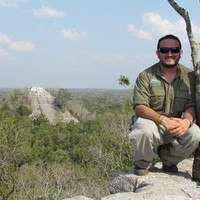Papers by Trimanto Trimanto
RAPD analysis to reveal the genetic diversity among closely related Etlingera species of Achasma group, Zingiberaceae
AIP conference proceedings, 2024
Nucleation and Atmospheric Aerosols, 2017
This research is aimed to inventory and collect ginger species from Borneo, especially from Besiq... more This research is aimed to inventory and collect ginger species from Borneo, especially from Besiq Bermai forest, East Borneo forest. This research was conducted by surveys and using a purposive sampling method. The characterization of Borneo gingers also used a guide to ginger of Borneo. The results showed that there are 19 species which have been recorded in this forest.

Proceeding Biology Education Conference: Biology, Science, Enviromental, and Learning, Oct 16, 2013
Kegiatan rutin yang dilakukan di unit seleksi dan pembibitan di Kebun Raya Purwodadi adalah aklim... more Kegiatan rutin yang dilakukan di unit seleksi dan pembibitan di Kebun Raya Purwodadi adalah aklimatisasi dan perbanyakan tanaman. Aklimatisasi merupakan pengadaptasian terhadap tumbuhan-tumbuhan yang akan ditanam sebagai koleksi Kebun Raya Purwodadi. Tahapan aklimatisasi tumbuhan umum non-anggrek meliputi penanaman material, penyungkupan, penjarangan, perawatan dan monitoring. Kegiatan rutin lain yang dilakukan unit ini adalah perbanyakan tanaman. Beberapa perbanyakan tanaman yang dilakukan adalah perbanyakan tanaman kritis koleksi kebun raya dan perbanyakan tanaman yang menunjuang pameran, dekorasi dan taman. Kegitaan rutin di unit seleksi dan pembibitan bertujuan dalam penyediaan bibit tanaman untuk keperluan pengelolaan koleksi, kebun koleksi dan kegiatan pendayagunaan tanaman koleksi.

Nusantara bioscience, 2010
Trimanto, Sajidan, Sugiyarto. 2011. Characterization of taro (Colocasia esculenta) based on morph... more Trimanto, Sajidan, Sugiyarto. 2011. Characterization of taro (Colocasia esculenta) based on morphological and isozymic patterns markers. Nusantara Bioscience: 7-14. The aims of this research were to find out: (i) the variety of Colocasia esculenta based on the morphological characteristics; (ii) the variety of C. esculenta based on the isozymic banding pattern; and (iii) the correlation of genetic distance based on the morphological characteristics and isozymic banding pattern. Survey research conducted in the Karanganyar district, which include high, medium and low altitude. The sample was taken using random purposive sampling technique, including 9 sampling points. The morphological data was elaborated descriptively and then made dendogram. The data on isozymic banding pattern was analyzed quantitatively based on the presence or absence of bands appeared on the gel, and then made dendogram. The correlation based on the morphological characteristics and isozymic banding pattern were analyzed based on the product-moment correlation coefficient with goodness of fit criterion. The result showed : (i) in Karanganyar was founded 10 variety of C. esculenta; (ii) morphological characteristics are not affected by altitude; (iii) isozymic banding pattern of peroxides forms 14 banding patterns, esterase forms 11 banding patterns and shikimic dehydrogenase forms 15 banding patterns; (iv) the correlation of morphological data and the isozymic banding pattern of peroxidase has good correlation (0.893542288) while esterase and shikimic dehydrogenase isozymes have very good correlation (0.917557716 and 0.9121985446); (v) isozymic banding pattern of data supports the morphological character data.
Study of population and conservation of Dendrobium capra J.J. Smith, an endangered and endemic orchid from Java Island, Indonesia
Journal for Nature Conservation
A New Species of Dendrobium Section Spatulata From Maluku, Indonesia
Phytotaxa, 2021
Dendrobium dedeksantosoi, a new species of Dendrobium section Spatulata (Orchidaceae: Epidendroid... more Dendrobium dedeksantosoi, a new species of Dendrobium section Spatulata (Orchidaceae: Epidendroideae) from Maluku Islands, Indonesia, is described and illustrated. The flower of this new species is morphologically most similar to Dendrobium busuangense, but differs in having different shape and size of petals and lip as well as a different length ratio between column and column-foot.

IOP conference series, Dec 1, 2021
Alpinia warburgii is a species of the Zingiberaceae family native to Sulawesi. This study aims to... more Alpinia warburgii is a species of the Zingiberaceae family native to Sulawesi. This study aims to characterize the plant morphology; analyze the anatomical structure, histochemical localization, and secretory cell structure of the rhizome; also discuss the potential and conservation effort of the species. Anatomical study and histochemical tests were observed microscopically using the fresh preparation method and wet mounted slide. Histochemical tests carried out include starch, protein, lipid, tannin, alkaloid, and flavonoid. This study is considered the first report of histochemical tests on A. warburgii. The main morphological characteristics of A. warburgii are perennial herbaceous; inflorescence terminal and raceme; flowers white, labellum obovate with red lines in the middle, and flanked by light green edges; fruit globose, green when young and yellow when ripe. The rhizome anatomical structure comprises the epidermis, endodermis, hypodermis, parenchyma, cortex, and vascular bundles, classified as closed collateral type. Histochemical tests showed positive localization for starch, protein, alkaloids, flavonoids, and tannins. The density of flavonoids secretory cells is higher than tannins and alkaloids, which indicates its potential as medicine to be associated with antioxidant, antimicrobial, antiinflammation, and anticancer. In addition to in-situ, ex-situ conservation effort through propagation is also important to maintain the species.

Journal of Tropical Biodiversity and Biotechnology, 2022
Wild bananas provide important genetic materials for further banana improvement, therefore they n... more Wild bananas provide important genetic materials for further banana improvement, therefore they need to be conserved and studied. This study aimed to describe morphological characteristics of plant and seed and also to study the seed germination of wild banana M. acuminata var. flava (Ridl.) Nasution. The morphological characteristics were observed descriptively by referring to the descriptor for banana. The internal and external morphology of the seeds were observed using a digital microscope. The germination testing was carried out by a completely randomized design, using fresh seeds extracted from a bunch of fruits with two ripeness levels i.e. fully-ripe (yellow peel) and under-ripe (green-yellow peel). The data resulted was then analyzed using an independent t-test. The results showed that M. acuminata var. flava is characterized as a perennial herb; pseudostem height ≥3 m; male bud like a top with prominent green-yellow bracts; fruit curved and tasted mild-sweet when ripe. The...

TURKISH JOURNAL OF BOTANY, 2021
Open-cast mining in tropical forests causes negative impacts on biodiversity and carbon storage. ... more Open-cast mining in tropical forests causes negative impacts on biodiversity and carbon storage. Postmining reclamation is therefore imposed to recover the vegetation despite the lack of understanding which indicators can be used to monitor the progress of succession. This study proposes an integrated framework to assess the trajectory of vegetation succession in coal mining site in East Kalimantan, Borneo. We combine the indicators of floristic diversity of naturally growing terrestrial and epiphytic plants, survival and growth of enrichment planting of native plants, above-ground carbon stock of pioneer trees, and the measurements on micro-climate and soil conditions. We compare some indicators across the 9-year-old and 17-year-old reclaimed sites and the premining sites. The results showed that naturally growing vegetation at the reclaimed sites was at the early to midsuccession stages, with biodiversity indicators much lower than those at the premining areas, implying the necessity of native species planting. During a six-month monitoring, the enrichment planting of native species had high rates of survival and growth. Surprisingly, the above-ground carbon at the two reclamation sites were higher, up to six times larger, than that at the premining sites. While the micro-climates had been improved, the soils in the reclaimed sites were still in poor conditions. Our findings suggest that using single parameter to monitor the trajectory of vegetation succession in postmining reclamation can be biased, and integrating several monitoring measures would provide a much better assessment.

Journal of Tropical Biodiversity and Biotechnology, 2020
Bawean Island is a small island located between two islands (Java and Borneo). Geographically, th... more Bawean Island is a small island located between two islands (Java and Borneo). Geographically, the diversity of plants, especially epiphytic plants on this island is very interesting to be studied. This research aims to investigate the diversity of epiphytic plants, focussing on epiphytic orchids, Hoya and Dischidia in Bawean Island Nature Reserve and Wildlife Reserve. It was conducted through an inventory of epiphytic orchids and hoya growing on host trees. The results showed there were 10 species of epiphytic orchid and 3 species of epiphytic Hoya, and 1 species of Dischidia growing on-location studies. The epiphytic orchids which found in location studies included Phalaenopsis amabilis, Aerides odorata, Cymbidium aloifolium, Dendrobium anosmum, Rhynchostylis retusa, Liparis condylobulbon, Taeniophyllum biocellatum, Cymbidium sp., Eria sp. Orchid species that most often found in the study location was Phalaenopsis amabilis. In addition, this study recorded Taeniophyllum biocellatu...

Biodiversitas Journal of Biological Diversity, 2020
Comparative vegetation analyses subjected to recolonization of spontaneous plants were carried ou... more Comparative vegetation analyses subjected to recolonization of spontaneous plants were carried out in two post-coal mining reclamation sites, with different ages of reclamation, specifically 9 years old and 17 years old, in Bontang, East Kalimantan. This study aims to determine the spontaneous plant diversity and composition, identify the spontaneous alien plant species invasion (IAS), analyze the underlying micro-climates and soil factors and their association to the spontaneous plant recolonization, also to evaluate the succession progress. Results showed that both reclamation sites have undergone some vegetation and environmental improvements. The plant succession stage of both sites was identified at the same stage, as establishment phase of early-succession stage in transition to mid-succession stage. The spontaneous plants were comprised of two layers, i.e. (i) understories include grasses, ferns, lianas, herbs, shrubs and tree seedlings; and (ii) saplings include some of trees and small trees. Plant diversity indices on both sites were in moderate category. At understory layer, the 9-y.o. site was mostly dominated by grass Polytrias indica, whereas the 17-y.o. site was dominated by shrub Asystasia gangetica. At sapling layer, the 9-y.o. site was mostly dominated by Glochidion obscurum, whereas the 17-y.o. site was dominated by Macaranga tanarius. Dominant pioneer tree and shrub species in two reclamation sites mostly from general species component of secondary tropical forests from the families Euphorbiaceae, Phyllantaceae, Melastomaceae, Leguminosae, and Lamiaceae. It was recorded seven IAS in the 9-y.o. site, which six out of seven species were dominant. Meanwhile, in the 17-y.o. site was recorded eight IAS but only four species were dominant. Two dominant noxious weed species were also identified. Each IAS and noxious weed species has invasiveness traits that make them well-grown, successfully recolonized and invaded the reclamation site. Environmental factors include air temperature, air moisture, and light intensity; and soil conditions include pH, C/N ratio and physicochemical properties affected the variation of spontaneous plant establishment on each reclamation site. These comparative study findings may become inputs for coal mining operations management to evaluate and improve their reclamation program; such as by soil reconditions, controlling the populations of IAS, and planting more intensively of native tree species.

Journal of Tropical Life Science, 2018
This research was conducted to gather basic information to support recovery coal mining area with... more This research was conducted to gather basic information to support recovery coal mining area with study of flora biodiversity. Plants inventory were conducted explorative in Besiq Bermai forest. Some observations were conducted on plants as integral part of the documentation process. The result showed that there are 203 numbers of plant. They consist of 51 families of flora collection to be conserved in Purwodadi Botanic Garden. There are 53 species of orchid that collected from this forest, including of rare species and endemic orchid. There are 70 numbers of 1000 specimen floras to be collected in Nursery of coal mining to be used in reclamation program. There are 20 species of flora that be conserved because it is threatened species that based on IUCN. Ten species can be chosen to become pioneer species in reclamation of coal mining area. Biodiversity concept can be used in reclamation of post mining area. Prospective conservation area that called Arboretum is provided for in-situ conservation program. Some practical considerations are suggested for future reclamation projects.

Journal of the Bangladesh Agricultural University, 2019
An ethnobotanical study at Moyo Island, West Nusa Tenggara was carried out to record the traditio... more An ethnobotanical study at Moyo Island, West Nusa Tenggara was carried out to record the traditional knowledge and utilization of plant species there. It is expected that traditional knowledge can play a role in natural resource management systems which can be used in conservation programs. This research was conducted with field observational methods in the Moyo forest and interviews with local people that have knowledge about utilization of plants. There are about 48 species of plants which are utilized by the Brangkuah Community in Moyo Island. Most of them are collected from the forest and 21% (10 species) are cultivated. Local people also use plants for medicine 41% (21 species), food 39% (20 species) and building materials 16% (8 species). The Brangkuah have started to cultivate several plants which are used as building material and food plants which previously collected from the forest. The Brangkuah community has conserved useful plants for their daily life. It is expected ...

BERITA BIOLOGI, 2018
Curcuma is a genus of family Zingiberaceae. Its rhizomes, as well as leaves, have long been used ... more Curcuma is a genus of family Zingiberaceae. Its rhizomes, as well as leaves, have long been used in the traditional medicine. This research aimed to examine the morphological and anatomical structure as well as the primary and secondary metabolites of Curcuma aeruginosa Roxb, Curcuma longa L, and Curcuma heyneana Valeton & Zijp. The Anatomical structure, histochemical test and secretory cell density were observed microscopically. The Histochemical test consisted of amilum, protein, lipid, tanin, alkaloid dan flavonoid tests. Observation of anatomical structures of the of rhizome showed that starch grains has a medium size and shape of starch was oval. Rhizomes of Curcuma longa and C. aeruginosa had a positive correlation for starch, protein, lipids, alkaloids, flavonoids and tannins. C. heyneana has the highest density value on protein while C. longa has the highest density value on lipids, alkaloids, flavonoids and tannins.

Journal of Tropical Life Science, 2017
Nusa Tenggara consists of some small islands, one of them is Moyo Island. The diversity of plant ... more Nusa Tenggara consists of some small islands, one of them is Moyo Island. The diversity of plant species in this island is not really known for certain. This research was determined to observe the diversity of plant species in Moyo Island forest. The research was conducted in April 2013 by using floristic analysis method. The characteristic of Moyo Island forest is lowland evergreen rain forest. The results showed there were 60 tree species recorded in Moyo Island forest. There were many fruiting trees and seedling from the trees which show healthy growth, indicated that the plant regeneration in this forest is went well. The diversity of Pteridophytes and orchids were not high. Epiphytic fern which often found in the forest were Drynaria quersifolia and Platycerium bifurcatum and terrestrial orchid that dominated in the forest was Nervilia aragoana. Tuber plant was often found in this forest and grew prolifically were Tacca, Dioscorea and Amorphophallus. In coastal area lived a population of Pandanus tectorius. There were three new record plants found. The first was epiphytic orchid: Pteroceras javanica, the second was the epiphytic plant: Hoya verticillata and wild tuber plant: Tacca leontopetaloides.

Tropical Drylands, 2017
A number of plant accessions were collected from Moyo Island forest, West Nusa Tenggara, Indonesi... more A number of plant accessions were collected from Moyo Island forest, West Nusa Tenggara, Indonesia consisted of 123 accession numbers of general collection and 17 accession numbers of orchid collection. These plant materials were acclimatized at a nursery in Purwodadi Botanic Garden, Pasuruan, East Java, Indonesia. Acclimatization was aimed to determine successfully adapting plants from the forest, which are expected to survive and can be used as plants collection in Purwodadi Botanic Garden. The objective of this research was to identify the plant species of Moyo Island that can adapt in Purwodadi Botanic Garden and analyze the mechanism of their adaptation. The study was conducted at a nursery unit in 2013, with an observational method. The results show that 75% plant species collected from Moyo Island could adapt in Purwodadi Botanic Garden. We found 96 accessions of the general collection and nine accessions of the orchid collection that could adapt. The orchid collection was harder to adapt as compared to the general plant collection.

Biodiversitas, Journal of Biological Diversity, 2016
Trimanto, Hapsari L. 2016. Botanical survey in thirteen montane forests of Bawean Island Nature R... more Trimanto, Hapsari L. 2016. Botanical survey in thirteen montane forests of Bawean Island Nature Reserve, East JavaIndonesia: Conservation status, bioprospecting and potential tourism. Biodiversitas 17: 832-846. Bawean Island which located between Borneo and Java islands possessed unique and distinctive abiotic and biotic resources. Botanical survey has been conducted in Bawean Island Nature Reserve. This paper reported the results of inventory study of plant bioresources in 13 montane forests of Bawean Island, discussed their conservation status, bioprospecting on some wild plant species and potential development subjected to some conservation areas. Inventory results in montane forests showed that it was registered about 432 plant species under 286 genera and 103families; comprised of 14 growth habits in which tree plants were the most dominant with about 237 species. Conservation status evaluation showed that there are at least 33 species of plants included in IUCN list comprised ...

Agrivita
Dioscorea spp. is local tuberous food crop that has potential as alternative food source to suppo... more Dioscorea spp. is local tuberous food crop that has potential as alternative food source to support food security program in Indonesia. Exploration study and collecting mission subjected to Dioscorea spp. have been conducted in Nganjuk Regency. The study was aimed to 1) determine the distribution of Dioscorea spp. in Nganjuk, 2) to characterize tuber’s morphological characteristic, and 3) to know how tuber’s utilization by local peoples. The results showed that there were 4 species of Dioscorea found in Nganjuk. They are Dioscorea alata L, Dioscorea esculenta (Lour.) Burkill, Dioscorea hispida Dennst and Dioscorea bulbifera L. Dioscorea alata (uwi) is the most cultivated by farmers in Nganjuk. It has the largest cultivar numbers which consists of 11 cultivars. Dioscorea esculenta (gembili) consists of 3 cultivars and Dioscorea hispida (gadung) consists of 4 cultivars, whereas Dioscorea bulbifera (uwi gantung) consists only 1 cultivar in one location. Farmers and local peoples play i...

Biodiversitas Journal of Biological Diversity, 2018
Trimanto, Hapsari L. 2018. Short communication: A new record of Etlingera megalocheilos (Griff.) ... more Trimanto, Hapsari L. 2018. Short communication: A new record of Etlingera megalocheilos (Griff.) A.D. Poulsen(Zingiberaceae) in Sulawesi, Indonesia. Biodiversitas 19: 1227-1235. A through morphological examination has been conducted to aliving specimen of Zingiberaceae collection of Purwodadi Botanic Garden, East Java which was collected from Pangi Binangga NatureReserve, Central Sulawesi. The result showed that the characters of the species match very well with the description of Etlingeramegalocheilos. The distribution of E. megalocheilos was previously reported to occur only in Sundaland includes Peninsular Malaysia,Singapore, Sumatra, Java, and Borneo. Thus, E. megalocheilos is a newly recorded species in Sulawesi; and confirmed that itsdistribution record now has expanded to Wallacea. The key morphological characters of E. megalocheilos are labellum hourglassshaped,dull red or red to orange-red with the yellow margin, the anther is not covered by the corolla lobe, and have slig...

Biodiversitas Journal of Biological Diversity, 2019
Heliconia L. is a single genus in the family Heliconiaceae, with approximate consists of 200 spec... more Heliconia L. is a single genus in the family Heliconiaceae, with approximate consists of 200 species. It has wide morphological variations among and within species which led to problems in species identification. Species diversity and phylogenetic analysis using morphology and rbcL marker subjected to 17 Heliconia spp. living collections of Purwodadi Botanic Garden (PBG) have been conducted. The rbcL gene located in chloroplast genome is one of appropriate proposed marker for plant barcoding assessment. This study aimed to study morphology and genetic variability of the PBG Heliconiaceae collections, to confirms the species name for a more accurate identity record and to reveal the diversity and phylogenetics of the species. Morphological characterization showed high variability among Heliconia species, which included 3 subgenera (Heliconia, Stenochlamys, and Griggsia) and 1 hybrid. Each species possessed unique morphological characteristics. The common morphological characters which distinguished among and within Heliconia species includes leaf form, inflorescence type, and bract characteristics. Key to the Heliconia species examined is presented in this paper. However, molecular confirmation using rbcL sequences showed high conservation level (0.932) and low genetic variability. About 656 nucleotides were monomorphic and 33 positions were polymorphic which comprised 18 singleton variable sites and 15 parsimony informative sites. Twelve haplotypes were produced with haplotype diversity value 0.8952. Pairwise distance analysis shows that they were shared high similarity of rbcL sequences with very low genetic distance (0.022 to 0.000). The topology of phylogenetic tree resulted by Neighbour-Joining algorithm has the best grouping and be able to explain the relationship among species of Heliconia, although supported by low bootstrap (65). It was separated into two clades following its subgen. classification. Clade 1 consists of subgen. Heliconia and Griggsia; while clade 2 consists of subgen. Heliconia and Stenochlamys; also hybrid species. Further, separation of deeper branchings (section) was inconsistent and unclear. Upon this study, rbcL marker was considered too conserved thus less valuable for phylogenetic analysis at lower taxa among and within Heliconia spp. However, rbcL was suggested to distinguish at higher level taxa between closely related genus and above.











Uploads
Papers by Trimanto Trimanto